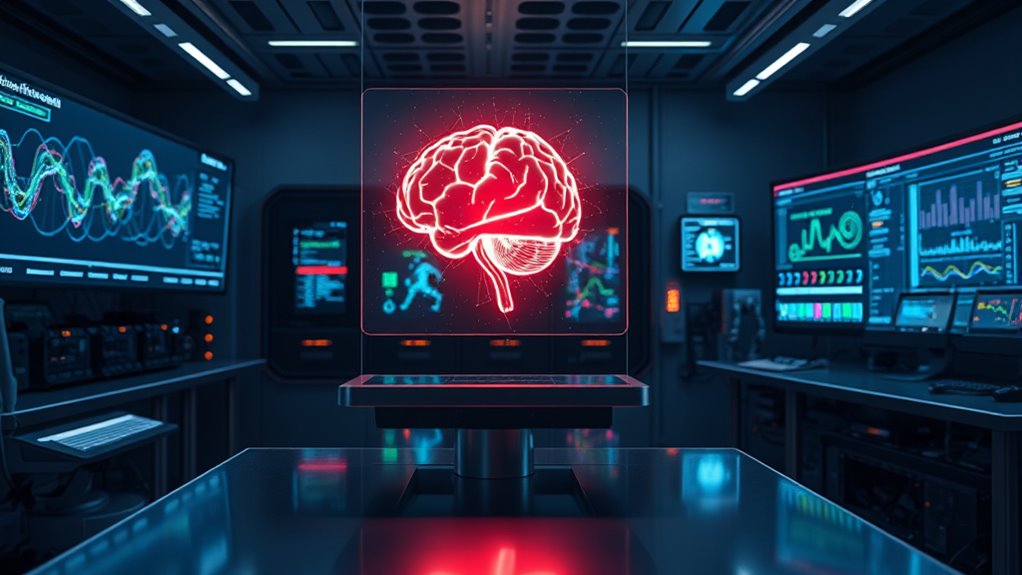Meta-reinforcement learning helps you create agents that learn to learn, enabling quick adaptation across various tasks by focusing on optimizing their learning processes. Instead of just solving single problems, these systems develop strategies to improve themselves based on past experiences. You’ll see how they use advanced algorithms to handle new challenges efficiently. If you explore further, you’ll discover how this approach is transforming AI into more flexible and resilient systems that adapt seamlessly to changing environments.
Key Takeaways
- Meta-RL enables agents to learn how to adapt quickly to new tasks by leveraging past experiences.
- It involves a two-level learning process: outer loop for generalization, inner loop for task-specific adaptation.
- Advanced algorithms like neural networks and probabilistic models enhance the agent’s ability to generalize.
- Applications include robotics, autonomous systems, and personalized recommendations that require adaptability.
- It shifts AI development toward creating more resilient, continuously learning agents capable of handling unpredictable environments.

Meta-reinforcement learning (meta-RL) is a cutting-edge approach that enables agents to learn how to learn. Instead of just mastering a single task, you’re equipping your agent with the ability to adapt quickly to new, unseen environments. This method mimics human learning, where past experiences inform future decisions, allowing your agent to transfer knowledge efficiently. In fundamental terms, meta-RL focuses on optimizing the learning process itself, so your agent doesn’t start from scratch each time it faces a new challenge. Instead, it uses previous experiences as a foundation, enabling rapid adaptation and improved performance. This approach is particularly useful in situations where tasks are diverse or change over time, requiring your agent to be flexible and adaptive rather than static.
You’ll find that meta-RL typically involves a two-level learning process. The outer loop trains the agent on a distribution of tasks, teaching it how to adapt quickly. During this phase, the agent learns a strategy or a set of parameters that can be fine-tuned efficiently for new tasks. The inner loop is where the agent applies these learned strategies to solve specific tasks, updating its policies based on immediate feedback. This combination allows your agent to develop a kind of meta-knowledge—an understanding of how to approach new problems based on past experiences. The beauty of this setup is that it minimizes the amount of data and time needed to learn new tasks, which is a game-changer in environments where data is scarce or expensive to obtain.
Additionally, contrast ratio plays a crucial role in how well the agent can interpret and adapt to visual information during learning, especially in tasks involving perception or visual decision-making. As you implement meta-RL, you’ll notice it often involves advanced algorithms like model-based approaches, probabilistic models, or deep neural networks. These tools help your agent generalize from previous tasks to new ones more effectively. Your goal is to design systems that can quickly interpret new information, adjust their strategies, and improve outcomes without requiring extensive retraining. This flexibility is especially valuable in real-world applications like robotics, autonomous vehicles, or personalized recommendations, where conditions are constantly changing. By focusing on the process of learning itself, meta-RL pushes your system toward true adaptability, enabling it to handle complexity and variability with remarkable efficiency.
Ultimately, by mastering meta-RL, you’re creating agents that don’t just perform well on specific tasks but learn to learn, becoming more intelligent, resilient, and capable over time. This paradigm shift from static algorithms to adaptable learners marks a significant step forward in artificial intelligence, promising smarter systems that can handle the unpredictable nature of real-world environments.
Frequently Asked Questions
How Does Meta-Reinforcement Learning Differ From Traditional Reinforcement Learning?
Meta-reinforcement learning differs from traditional reinforcement learning because it enables you to learn how to learn across multiple tasks. Instead of just optimizing for a single goal, you adapt quickly to new environments by leveraging prior experience. This approach allows you to develop flexible strategies and generalize better, making you more efficient in solving new problems with minimal additional training, unlike traditional methods that focus on one task at a time.
What Are the Key Challenges in Implementing Meta-Reinforcement Learning?
You might find the key challenges in implementing meta-reinforcement learning are often subtle but impactful. You need to balance learning new tasks quickly without forgetting previous ones, which can be tricky. Fine-tuning algorithms to adapt efficiently demands patience and precision. Additionally, managing computational resources wisely guarantees smooth training. Overcoming these hurdles requires careful design and experimentation, but with persistence, you’ll find innovative solutions that enhance your agent’s ability to learn how to learn.
Can Meta-Reinforcement Learning Generalize Across Very Different Tasks?
Yes, meta-reinforcement learning can generalize across very different tasks, but it’s challenging. You need a diverse training set to help the agent develop adaptable strategies. The key is designing algorithms that learn flexible representations, enabling quick adaptation to new tasks. While some models excel at broad generalization, others struggle with highly dissimilar tasks, highlighting the importance of carefully selecting training experiences and model architectures.
What Are Common Applications of Meta-Reinforcement Learning in Real-World Scenarios?
You can see meta-reinforcement learning used in various real-world scenarios like robotics, where it helps robots adapt quickly to new tasks or environments. It’s also applied in personalized recommendations, enabling systems to tailor content based on user preferences. Additionally, it’s useful in finance for rapid decision-making, and in healthcare for personalized treatment plans. Its ability to learn how to learn makes it valuable across diverse fields requiring adaptable, efficient AI solutions.
How Does Meta-Learning Improve the Efficiency of Reinforcement Learning Agents?
Meta-learning turbocharges your reinforcement learning agents by making them quick on the uptake. It’s like giving your agent a cheat sheet, so it learns new tasks faster and with less trial and error. Instead of starting from scratch, your agent leverages past experiences, saving time and resources. This means smarter, more adaptable agents that can pivot on a dime—making your AI seem downright genius.
Conclusion
By mastering meta-reinforcement learning, you enable agents to adapt quickly across diverse tasks, much like humans do. Remarkably, studies show these agents can improve their learning speed by up to 50% after just a few experiences. This statistic highlights how powerful learning to learn truly is, opening doors for more flexible, intelligent systems. Embrace this approach, and you’ll be at the forefront of creating adaptable AI that learns faster and smarter than ever before.








